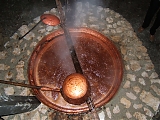Typical product of the territory of Abruzzo, it is known as one of the Italian traditional agro-food product certified by the Ministerial Department for Agriculture Food and Forestry Policies, thanks to AICS, an organization which has chosen Roccamontepiano as operative seat for the lasting secular tradition, passed on among the various localities and quarters of the village: Pomaro, Giancola, Reginaldo, Moreto, Via del Mulino, S. Angelo.
In Roccamontepiano it is going on a characterising action of this product and it has been founded the Voluntary Consortium "Association Producers of Vino cotto of Abruzzo, which every years organize a competition with a series of manifestations connected to it.
Since 2001, the Municipality of Roccamontepiano and the Association Producers of Vino Cotto of Abruzzo has organized "The celebration of Vino Cotto and Chestnuts"- Food and wine Paths of Autumn Flavours, which habitually occurs during the second week-end of September.
The celebration takes place in Terranova Square, inside Palaterranova, a heated area, and proposes a tasting of chestnut, vino cotto and typical products of the gastronomy of Abruzzo, with live music.
Features and qualities of Vino Cotto
Defined as being the wine of conviviality and hospitality, usually served as dessert wine, this product presents a variable alcoholic gradation on the base of the technique used in the production process and of the ageing period. It can taste crisp or sweet depending on the sugar residue, but it always has an aftertaste dry and sapid. It is characterized by its typical colour, ranging from amber to garnet red, and by an intense smell.
Vinification
The Vino Cotto, overall the long aged one, is prepared in the most favourable climatic years with the best grapes, only of the variety Montepulciano of Abruzzo, accurately chosen during the grape harvest of Roccamontepiano, and especially of Pomaro. After the pressing, the must is spilled in a big copper pot (lu callare) and then set in a firebox manufactured in the cellar for this occasion. It is indispensable to pay attention to the integrity of the pot, because it is usually bought from the copper workers of Guardiagrele and passed on generation by generation.
Once sure of having arranged some pieces of a dish from Rapino in the copper pot, there is the lighting of the fire, composed by compact resistant oak or olive wood, as recommended by the elderly people, trustworthy loyal necessary guardian of such antique tradition. To reduce the must at least of 80%, the cooking time can varies from 6 to 10 hours on the base of the year and of the sugar quality of the grapes.
The first part of cooking (30%) is for the foaming process; in the second part (next 20%), evaluating the concentration and the colour of the cooking must, it is decided the entity of "svacata", that is the quantity of full selected berries to be add to the pot. After the reduction of a further 20%, normally a pair of litres of cocked must is taken to be used in the preparation of the traditional Christmas pastries (caviciùne and pizzelle) and for other culinary uses.
After a further reduction of 10-15% "la cotta" (the cooked residual) is ready to be poured in an uncooked must, which waits for in its barrel. If an hectolitre of must reduces till 15-20 litres, this quantity will be stilled in a barrel containing 100 litres of uncooked must.
At this time it is necessary to wait for the next July to check and taste attentively that wine to establish if it has all the features requested by the tradition. If the evaluation is positive, it will start a long ageing process. Within 10 years, it will be still considered as new vino cotto, considering that the ageing process can be extended till 20-30 years and above.















